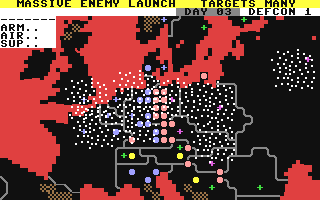|
THEATRE
EUROPE
PSS,
£9.95 cass, £12.95
disk, joystick and keys
|
|

JUNE
|
O
Remarkable new simulation of east/west conflict
O Conventional warfare, nuclear and chemical strikes
O Authentic and chilling atmosphere, absorbing
action
|
Cold,
grim nuclear reality. That's what this game is about.
This new approach to a war game brings home the horrors
of global nuclear holocaust. Here, though, it's up to
you to stop it from happening.
Although
this is essentially a war game, it uses a series of
different screen types to depict the action in an atmospheric,
nail-biting way -- and there are also a couple of actual
arcade action screens.
The
game starts with an absolutely magnificent and appropriate
piece of music -- the Lennon/McCartney song 'Give Peace
a Chance'. This, coupled with a pledge in the instructions
that the game is dedicated to peace, give it a superbly
sober atmosphere from the start.
You
then have several selections to make:
O
one of three levels against the computer.
O
whether you want to command the NATO forces or the Warsaw
Pact.
O
whether you want to include the arcade sequences.
Next
you will be presented with a detailed map of Europe
and Western Russia (including Moscow). The map shows
mountain ranges, capital cities, country borders, and
all the armed forces of both sides.

First
you have the option to MOVE your units. Simply place
your box-like cursor over the desired unit, press fire
button, and then move the cursor to where you'd like
the unit to move to. You can only move one character
space at a time and the unit will move as soon as you
press the fire button again.
Next
comes ATTACK. This has exactly the same sort of control
as moving, this time positioning the cursor over the
enemy unit you'd like to attack. Once a unit is sent
into battle it cannot be halted until your turn is over.
When
all attacking forces are in operation you can FIGHT.
If you have selected the action screen mode, then you
can choose which battle you'd like to take part in.
You are then engaged in an arcade-type shoot-em-up.
If you've decided to leave the action screens out, then
the battle will be decided on merits of air superiority,
supplies and armament.

A
massive enemy launch of nuclear weapons
is
under way and your reflex system has
responded with its own devastating strike.
After
the battle you can REBUILD your units with somewhat
scant supplies. Firstly you are given a quantity of
armament supplies -- these can be issued to the more
desperate forces by positioning the cursor over the
unit and pressing fire a certain number of times according
to how many supplies you want sent. As with every type
of supply, you must plan carefully your rebuilding schedule:
once a supply is sent it cannot be reclaimed.
The
next batch of supplies to come in are the air support.
These are used to rebuild your units in similar fashion
to the armament. Again, they are very limited and have
to be used wisely.
Once
rebuilding has finished, you move onto the AIR phase.
This is to determine how you're going to use your air
command during your next go. You have spare aircraft
which you can access, but which will run out if you
use too much. There are several options which you can
allocate these to, some essential and some tactical.

The
missiles have nearly reached their targets.
Essential
options are air power (the most important), counter
air strikes, and reconnaissance. Other options include
interdiction, assault breakers, deep strike, and iron
snake.
COUNTER
AIR STRIKES are attacks on enemy airfields and bases;
this will all help in the overall battle for air superiority.
INTERDICTION
is sending planes behind enemy lines to attack the enemy
supply and movement network. It has a minor risk of
setting off a nuclear strike.
The
other three are respectively an attack on one particular
unit (high success rate), a strike into enemy territory,
and an attack on railways to disable enemy reinforcements.
Finally you have the option to use a SPECIAL MISSION,
basically setting off a strategic chemical or nuclear
launch (see separate box).
After your go it's the computer turn, and it'll take
its go in exactly the same way as you. This time, though,
it'll fire any special missions at the beginning of
its move.
JR
.
|